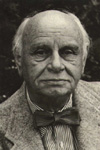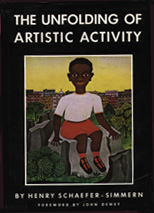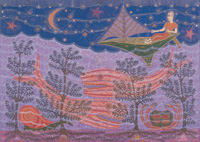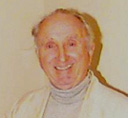|
Until his death in 1978, Henry Schaefer-Simmern, a
distinguished art educator and the author of
The Unfolding of Artistic Activity and The Essence
of the Artistic Form, studied children's untutored
drawings and works of primitive and prehistoric art, in
a search for the principles of that visual conceiving
which most vitally affect artistic activity.
Kerwin Whitnah took over Schaefer-Simmern's children's school in Berkeley
in 1965.
  Henry
Schaefer-Simmern, when I first met him, was a large and
imposing person of obviously high intelligence. But, when
I got to know him I discovered that his bright intelligence
was always in service to a more demanding power -- namely,
a passion for the artistic form, and how to make it and
how best to teach it to others. This, of course, was an
unusual passion to find anywhere in this age when art is
among the lowest values at the bottom of a
mutifarious agenda, largely devoted to scientific
materialism.
Schaefer-Simmern well knew that the odds were against him.
Nevertheless, knowing surely how high the stakes were, he
taught with a sure hand, an unfailing enthusiasm, and a
deep love for his subject matter. Henry
Schaefer-Simmern, when I first met him, was a large and
imposing person of obviously high intelligence. But, when
I got to know him I discovered that his bright intelligence
was always in service to a more demanding power -- namely,
a passion for the artistic form, and how to make it and
how best to teach it to others. This, of course, was an
unusual passion to find anywhere in this age when art is
among the lowest values at the bottom of a
mutifarious agenda, largely devoted to scientific
materialism.
Schaefer-Simmern well knew that the odds were against him.
Nevertheless, knowing surely how high the stakes were, he
taught with a sure hand, an unfailing enthusiasm, and a
deep love for his subject matter.
 He was then, if you accepted his thesis that we are all
created creative, someone to trust. Or, as they used to
say in the late 19th century on the Nevada frontier: "He
was a man to ride the river with!" He was then, if you accepted his thesis that we are all
created creative, someone to trust. Or, as they used to
say in the late 19th century on the Nevada frontier: "He
was a man to ride the river with!"
 He was not interested in promiscuous praise, either for
himself or for others, but only in the Truth of the
Artistic Form, wherever that might lead. Shortly after he
arrived in the United States as a refugee from the
Frankfurt Gestapo ("Every time I heard the word 'culture'
I reach for my revolver!", he said, remembering that
time), he had a long and promising
interview with a faculty member at a large U.S.
university. After the interview was over and his host had
indicated good auguries for a future association,
Schaefer-Simmern said: "I have really enjoyed meeting with
and talking to you. But there is only one problem --" He was not interested in promiscuous praise, either for
himself or for others, but only in the Truth of the
Artistic Form, wherever that might lead. Shortly after he
arrived in the United States as a refugee from the
Frankfurt Gestapo ("Every time I heard the word 'culture'
I reach for my revolver!", he said, remembering that
time), he had a long and promising
interview with a faculty member at a large U.S.
university. After the interview was over and his host had
indicated good auguries for a future association,
Schaefer-Simmern said: "I have really enjoyed meeting with
and talking to you. But there is only one problem --"
  "Oh", said his host, "What is that?" To which
Schaefer-Simmern answered gently, but conclusively:
"You don't know anything about art!" Quite naturally, he
did not get the job. Shortly afterwards, his book,
"The Unfolding of Artistic Activity", was published by the
University of California Press. And at that point he was
hired by the University of California in Berkeley. In
1949, wishing to expand his teaching work in a way not
possible at U.C. Berkeley, he opened his own school, The
Institute of Art Education, and soon had almost more
students than he could handle, including children. "Oh", said his host, "What is that?" To which
Schaefer-Simmern answered gently, but conclusively:
"You don't know anything about art!" Quite naturally, he
did not get the job. Shortly afterwards, his book,
"The Unfolding of Artistic Activity", was published by the
University of California Press. And at that point he was
hired by the University of California in Berkeley. In
1949, wishing to expand his teaching work in a way not
possible at U.C. Berkeley, he opened his own school, The
Institute of Art Education, and soon had almost more
students than he could handle, including children.
 He was not a hail fellow, well-met or someone who
practised: "You scratch my back, and I will scratch yours"
but rather one who believed that integrity, truth and hard
work were indivisible monitors of quality in a work of art.
So his teaching classes were not filled with encomiums of
praise. Quite the contrary, you could be with him a long
time and if you "got" his message and really put it into
practice he might say occasionally: "Oh, I see you are
beginning to understand." Which, if you knew him, would
be high praise indeed! He was not a hail fellow, well-met or someone who
practised: "You scratch my back, and I will scratch yours"
but rather one who believed that integrity, truth and hard
work were indivisible monitors of quality in a work of art.
So his teaching classes were not filled with encomiums of
praise. Quite the contrary, you could be with him a long
time and if you "got" his message and really put it into
practice he might say occasionally: "Oh, I see you are
beginning to understand." Which, if you knew him, would
be high praise indeed!
 I had been associated with him since 1949 when I became a
student in his Laymen's Class in "The Unfolding of Artistic
Activity". Often I would drive him to St. Mary's College
where he was giving a course, and I was also able to set
up a very extended and successful lecture series at U.C.
Berkeley. And I also began to help him by teaching some of
his children's classes. Teaching in San Francisco,
St. Mary 's and Berkeley, he was definitely overloaded and
unable to travel much to Europe, which was necessary for
his ongoing research. In 1965 he announced in the
Laymen's Class that he would have to close the children's
school, simply because he couldn't accomplish his important
book, "The Essence of the Artistic Form," on top of other
activities. So I offered to take over the children's class
completely and also do whatever was necessary for the
layman's course. He then, would be free to travel to
Europe, continue research, and finish his writing. He
accepted this and so I took over the children's class --
and it did not close. I had been associated with him since 1949 when I became a
student in his Laymen's Class in "The Unfolding of Artistic
Activity". Often I would drive him to St. Mary's College
where he was giving a course, and I was also able to set
up a very extended and successful lecture series at U.C.
Berkeley. And I also began to help him by teaching some of
his children's classes. Teaching in San Francisco,
St. Mary 's and Berkeley, he was definitely overloaded and
unable to travel much to Europe, which was necessary for
his ongoing research. In 1965 he announced in the
Laymen's Class that he would have to close the children's
school, simply because he couldn't accomplish his important
book, "The Essence of the Artistic Form," on top of other
activities. So I offered to take over the children's class
completely and also do whatever was necessary for the
layman's course. He then, would be free to travel to
Europe, continue research, and finish his writing. He
accepted this and so I took over the children's class --
and it did not close.
 At this point, I also confessed to him that I was beginning
to understand as never before what the real meaning of his
work was all about. Working at his desk, he looked up
abruptly and said: "Good you say so!" Now we can really
begin!" At this point, I also confessed to him that I was beginning
to understand as never before what the real meaning of his
work was all about. Working at his desk, he looked up
abruptly and said: "Good you say so!" Now we can really
begin!"
  At about this time I began to work
on The Voyage. I told
him nothing about this project, simply because I wanted to
present him with a finished picture, and not with a
problematic fragment. Because my wife was mortally ill
and I had a 3-year old son to take care of, it took me
about three years, working nights, to complete the
painting. When it was finished, I invited
Schaefer-Simmern to my house for breakfast. He came, and
before we sat down at the table, I uncovered the finished
work for him. He stood quietly before it for about a half
an hour, then asked me a few questions as to details, and
spoke about "how I could make it better" and then, before
we had breakfast said simply: "I see." After this, he
again went on a trip to Europe to see the art of Pompei and
Herculaneum and other early work in central Italy. When
he returned from this tour he would (as he put it)
"overlook" the classes. This time he was in a particularly
good mood. He liked what he saw at Pompei and Herculaneum
and he also liked what our students were doing in Berkeley.
And a few weeks later he said to me casually:
"You do a big painting like that, you can take your place
with the Etruscan painters." A very low-key statement,
delivered undramatically, but it made my day! And I also
knew that without his inspired teaching on "The Unfolding
of Artistic Activity", I
could not have accomplished it. At about this time I began to work
on The Voyage. I told
him nothing about this project, simply because I wanted to
present him with a finished picture, and not with a
problematic fragment. Because my wife was mortally ill
and I had a 3-year old son to take care of, it took me
about three years, working nights, to complete the
painting. When it was finished, I invited
Schaefer-Simmern to my house for breakfast. He came, and
before we sat down at the table, I uncovered the finished
work for him. He stood quietly before it for about a half
an hour, then asked me a few questions as to details, and
spoke about "how I could make it better" and then, before
we had breakfast said simply: "I see." After this, he
again went on a trip to Europe to see the art of Pompei and
Herculaneum and other early work in central Italy. When
he returned from this tour he would (as he put it)
"overlook" the classes. This time he was in a particularly
good mood. He liked what he saw at Pompei and Herculaneum
and he also liked what our students were doing in Berkeley.
And a few weeks later he said to me casually:
"You do a big painting like that, you can take your place
with the Etruscan painters." A very low-key statement,
delivered undramatically, but it made my day! And I also
knew that without his inspired teaching on "The Unfolding
of Artistic Activity", I
could not have accomplished it.
Back to the home page of The Voyage.
|




 Henry
Schaefer-Simmern, when I first met him, was a large and
imposing person of obviously high intelligence. But, when
I got to know him I discovered that his bright intelligence
was always in service to a more demanding power -- namely,
a passion for the artistic form, and how to make it and
how best to teach it to others. This, of course, was an
unusual passion to find anywhere in this age when art is
among the lowest values at the bottom of a
mutifarious agenda, largely devoted to scientific
materialism.
Schaefer-Simmern well knew that the odds were against him.
Nevertheless, knowing surely how high the stakes were, he
taught with a sure hand, an unfailing enthusiasm, and a
deep love for his subject matter.
Henry
Schaefer-Simmern, when I first met him, was a large and
imposing person of obviously high intelligence. But, when
I got to know him I discovered that his bright intelligence
was always in service to a more demanding power -- namely,
a passion for the artistic form, and how to make it and
how best to teach it to others. This, of course, was an
unusual passion to find anywhere in this age when art is
among the lowest values at the bottom of a
mutifarious agenda, largely devoted to scientific
materialism.
Schaefer-Simmern well knew that the odds were against him.
Nevertheless, knowing surely how high the stakes were, he
taught with a sure hand, an unfailing enthusiasm, and a
deep love for his subject matter.
